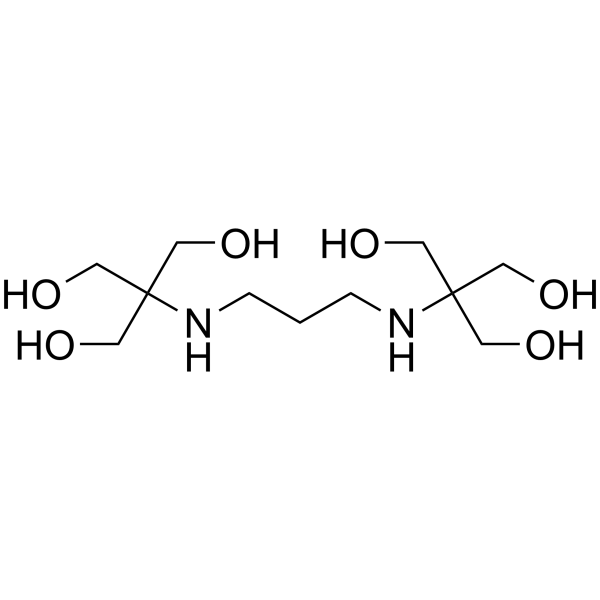BIS-TRIS PROPANE

BIS-TRIS PROPANE structure
|
Common Name | BIS-TRIS PROPANE | ||
|---|---|---|---|---|
| CAS Number | 64431-96-5 | Molecular Weight | 282.334 | |
| Density | 1.3±0.1 g/cm3 | Boiling Point | 573.3±50.0 °C at 760 mmHg | |
| Molecular Formula | C11H26N2O6 | Melting Point | 164-165 °C(lit.) | |
| MSDS | Chinese USA | Flash Point | 224.5±20.7 °C | |
Use of BIS-TRIS PROPANEBis-tris propane (BTP) is a water-soluble buffer substance. Bis-tris propane can be used as a suitable buffer for polymerase chain reaction (PCR). Bis-tris propane can enhance the stability or activity of restriction enzymes[1][2]. |
| Name | bis-tris propane |
|---|---|
| Synonym | More Synonyms |
| Description | Bis-tris propane (BTP) is a water-soluble buffer substance. Bis-tris propane can be used as a suitable buffer for polymerase chain reaction (PCR). Bis-tris propane can enhance the stability or activity of restriction enzymes[1][2]. |
|---|---|
| Related Catalog | |
| References |
| Density | 1.3±0.1 g/cm3 |
|---|---|
| Boiling Point | 573.3±50.0 °C at 760 mmHg |
| Melting Point | 164-165 °C(lit.) |
| Molecular Formula | C11H26N2O6 |
| Molecular Weight | 282.334 |
| Flash Point | 224.5±20.7 °C |
| Exact Mass | 282.179077 |
| PSA | 145.44000 |
| LogP | -1.89 |
| Vapour Pressure | 0.0±3.6 mmHg at 25°C |
| Index of Refraction | 1.565 |
| Storage condition | Store at RT. |
| Water Solubility | H2O: 1 M at 20 °C, clear, colorless |
| Personal Protective Equipment | Eyeshields;Gloves;type N95 (US);type P1 (EN143) respirator filter |
|---|---|
| Hazard Codes | Xn: Harmful; |
| Risk Phrases | R20/21/22;R36/37/38 |
| Safety Phrases | S22-S24/25-S26 |
| RIDADR | NONH for all modes of transport |
| WGK Germany | 3 |
| HS Code | 29221980 |
|
Induction of Neuron-Specific Degradation of Coenzyme A Models Pantothenate Kinase-Associated Neurodegeneration by Reducing Motor Coordination in Mice.
PLoS ONE 10 , e0130013, (2015) Pantothenate kinase-associated neurodegeneration, PKAN, is an inherited disorder characterized by progressive impairment in motor coordination and caused by mutations in PANK2, a human gene that encod... |
|
|
Phosphate modulates receptor sulfotyrosine recognition by the chemokine monocyte chemoattractant protein-1 (MCP-1/CCL2).
Org. Biomol. Chem. 13(7) , 2162-9, (2015) Tyrosine sulfation is a widespread post-translational modification that mediates the interactions of secreted and membrane-associated proteins in such varied biological processes as peptide hormone ac... |
|
|
Fragment-Based Discovery of Low-Micromolar ATAD2 Bromodomain Inhibitors.
J. Med. Chem. 58 , 5649-73, (2015) Overexpression of ATAD2 (ATPase family, AAA domain containing 2) has been linked to disease severity and progression in a wide range of cancers, and is implicated in the regulation of several drivers ... |
| 2,2'-(Propane-1,3-diyldiimino)bis[2-(hydroxymethyl)propane-1,3-diol] |
| 2,2'-(Propan-1,3-diyldiimino)bis[2-(hydroxymethyl)propan-1,3-diol] |
| BIS-Tris Propane,ULTROL Grade |
| Bistrishydroxymethylmethylaminopropane |
| BIS-TRIS PROPANE SIGMAULTRA |
| BIS-TRISPROPANE,BIOLOGICALBUFFER |
| BIS-TRIS PROPANE |
| 2,2'-(1,3-Propanediyldiimino)bis[2-(hydroxymethyl)-1,3-propanediol] |
| 1,3-Propanediol, 2,2'-(1,3-propanediyldiimino)bis[2-(hydroxymethyl)- |
| 1,3-Bis[tris(hydroxymethyl)methylamino]propane |
| MFCD00004689 |
| 2,2'-(Propane-1,3-diyldiimino)bis(2-(hydroxymethyl)propane-1,3-diol) |
| 1,3-Propanediol, 2,2'-(1,3-propanediyldiimino)bis(2-(hydroxymethyl)- |
| EINECS 264-899-3 |

